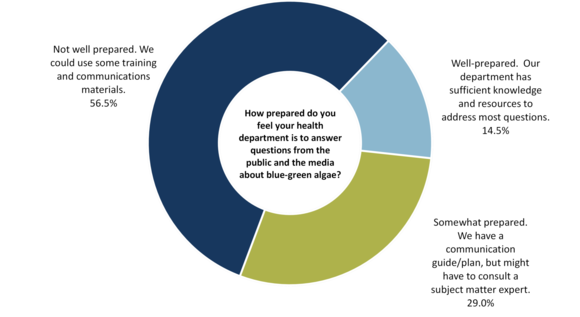 Welcome!
You may be thinking, "Why do we need a newsletter about harmful algal blooms when it's winter?" The purpose of this newsletter is to equip public health staff with the resources needed to tackle health-related blue-green algae issues—we’d like you to feel prepared when the next “bloom season” arrives. About once a month we’ll email you an issue with new materials, interesting facts, sample social media posts, and an interactive Q&A. In no time, you’ll be able to answer these questions like a pro:
- What are blue-green algae and what do they look like?
- How do blue-green algae make people sick?
- How do I feel confident when responding to media calls about blue-green algae?
- What do I do if a popular beach has a bloom?
- How do I report a blue-green algae-related illness?
 Missed a past issue? We'll save previous issues on our Resources for Health Professionals webpage.
Email us your burning questions! If others can benefit from hearing the answer to your question, we’ll feature it in a future issue.
Remember that we are always available for consultation on any HAB health-related issues by email or phone (608-266-1120).
|
What We Learned from You
Results from the 2018 Harmful Algal Blooms Survey
A huge "thank you" to the 55 local health jurisdictions that responded to the survey! Your feedback is extremely important. Our goal is to use the information you provided to guide the HAB Program activities so that we are most efficiently and effectively meeting health-related HAB needs at the local and tribal level. Here’s what we learned:
27% of local health jurisdictions did not know about the DPH HAB Program
The DPH HAB Program is celebrating 10 years of HAB-related illness prevention in Wisconsin! In 2008, the CDC started funding us and other states to improve surveillance and voluntary reporting of illnesses related to blue-green algae and algal toxin exposures. The CDC continues to help states maintain these activities with funding from the Great Lakes Restoration Initiative, which seeks to learn more about HABs and HAB-related illnesses occurring within the Great Lakes Basin. The DPH HAB Program:
- Collects and analyzes reports of human and animal illness associated with HAB exposure.
- Assists local health departments during illness investigations.
- Provides guidance on issuing health advisories and public beach or swim area closures.
- Participates in numerous outreach activities to improve awareness, understanding, and reporting of HABs and HAB-related illness.
60% have answered questions from the public regarding blue-green algae, but 57% feel that they are not well prepared to do so
 Reading this newsletter is a great way to start bolstering your skills! We also have a HAB Toolkit for public health professionals that includes a quick and simple background on cyanobacteria, exposure routes and symptoms, drinking water and recreational safety information, pet safety guidance, talking points, and message maps. You can find more resources on our website.
32% did not know that blue-green algae (cyanobacteria) and cyanotoxin poisoning became a reportable condition in Wisconsin
Blue-green algae (cyanobacteria) and cyanotoxin poisoning became a reportable condition in Wisconsin on July 1, 2018. Prior to July 1, we received HAB-related illness complaints voluntarily from citizens, local health departments, physicians and veterinarians, and the Wisconsin Poison Center. Now, all human illness complaints, no matter where they originate, must be reported to public health so they can be investigated. Due to the complexity of case investigation and risk assessment, the DPH HAB Program will perform case investigations unless local health departments choose to conduct initial routine follow-up for all cases in their jurisdictions.
To learn more about reporting requirements for local health departments and considerations while conducting an illness investigation, please visit the new Case Reporting and Investigation Protocol. We’ll include more information on reporting requirements and conducting illness investigations in future issues of this newsletter.
 With each issue, you will find a blue-green algae-related social media post written and ready to go. You are free to edit and modify to meet your needs; this is a resource to help make it easier for you to post about blue-green algae.
This issue’s sample post and photo:
Traveling for the holidays? While the season for cyanobacterial harmful algal blooms is over in Wisconsin, you might still find them in warmer climates. If water looks scummy or is discolored, stay out and don’t let your kids or pets swim in it. Learn more about blue-green algae: http://b.link/bgalgae
|
|